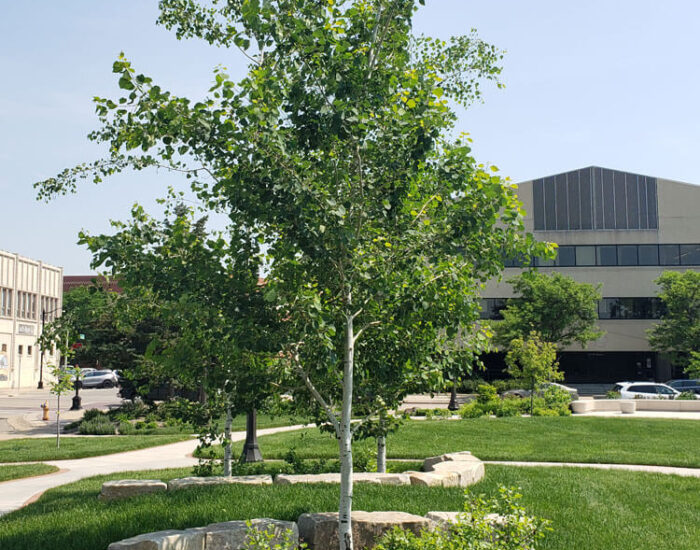Quaking Aspen
Populus tremuloides
Quaking Aspen is a fast-growing, narrow-oval to pyramidal, Wisconsin native tree with lustrous dark green foliage that shimmers in the slightest breeze. This pioneer species is quick to colonize open spaces, especially where there is bare soil. Its creamy white bark and rapid growth make a striking contrast to evergreens where Paper Birch will not grow. In fall, the foliage turns a beautiful golden yellow. An excellent adaptable species where it has room to grow.
Quaking Aspen is tremendously valuable to birds, insects, mammals, and more. It supports the larvae of the Great Ash Sphinx, Eastern Tiger Swallowtail, and Viceroy butterflies as well as a whole host of other insects. Aspen is also high value for our native Ruffed Grouse, which requires aspen of all age classes for habitat. In western states, the young sprouts are a food source for elk and moose. In fact, prior to the reintroduction of wolves to Yellowstone, there was a severe decline in Aspen regeneration as all the young seedlings were being eaten by elk. Once wolves were brought back to the park, however, there was a resurgence of Quaking Aspen as they were allowed to grow beyond small sprouts.
Quaking Aspen is the most widely distributed tree species in North America, ranging from Alaska to Colorado, and east across Canada to New England. The range of Quaking Aspen is restricted to areas where annual precipitation exceeds evapotranspiration. In layman’s terms, this means they grow best where there is a surplus of soil moisture. Its wide distribution also lends Quaking Aspen many names: Trembling Aspen, Trembling Poplar, Mountain Aspen, and Golden Aspen. You’ve likely heard it referred to as Poplar or Popple, but these names are also used as general terms for any Aspen species or member of the Populus genus.
So why do we call it Quaking Aspen? It’s because of how the foliage shimmers in the slightest breeze. This is due to two attributes of Aspen’s leaf- its shape and color. The underside of the foliage is a lighter, pale green, while the upper side is dark, lustrous green. When the foliage moves from side to side, the two-tone effect is amplified, and the motion can be seen from a great distance. But how does the foliage flip back and forth? The secret is in the petiole shape. On the leaves of most plants, the petiole (or leafstalk) is usually rounded and attaches to the base of the leaf. On Aspen, however, the petiole is more of a flattened oval shape and is arranged perpendicular to the leaf. This makes it sturdy and resistant to movement up and down, but weak when it comes to rotational movement.
A better question is why do the leaves quake? This has yet to be answered, but some hypothesize that the leaf movement prevents solar damage at higher elevations- think of it like how you get sunburnt out in the open but not under a tree, even though sunlight pokes through the canopy. Another hypothesis is that the movement deters insect predation of the foliage, or at least makes it more difficult for bugs to munch on them. More research is needed to determine if these benefits are what caused the foliage to evolve in this way, or if there are additional reasons yet unknown.
Quaking Aspen has numerous cultural uses. In Wisconsin, it is commonly used as pulpwood for paper production, but the wood can also be used to make plywood and OSB, lumber, and even veneer wood. It is especially useful for outdoor furniture (play structures, benches, etc.) as the wood surface does not splinter. Due to its fast growth rate, the species is also being evaluated for use as a biofuel or to make into processed animal feedstock.
Did you know that the oldest, largest, and heaviest organism on the planet is a stand of Quaking Aspen? It’s called Pando and it lives in Fishlake National Forest in Utah, occupying 106 acres. That’s about 1/8th the size of Central Park or a little over 80 football fields. It is estimated to weigh over 6,600 tons- or 55 blue whales (at 115 tons each, they’re the heaviest mammal), if that’s your preferred measurement. While the individual trees are of varying ages, the root system is conservatively estimated to be over 80,000 years old. Some estimates believe the colony could even be millions of years old! So the next time someone tells you that Aspens are a short-lived tree, you’re only hearing half the story.
Complete information on this species can be found at the source link below:
Information Source: https://kb.jniplants.com/quaking-aspen-populus-tremuloides
Plant Source: Johnson’s Nursery
Core Characteristics
Type: Shade
Origin: North America
Mature Height: 40-50 Feet
Mature Spread: 20-30 Feet

